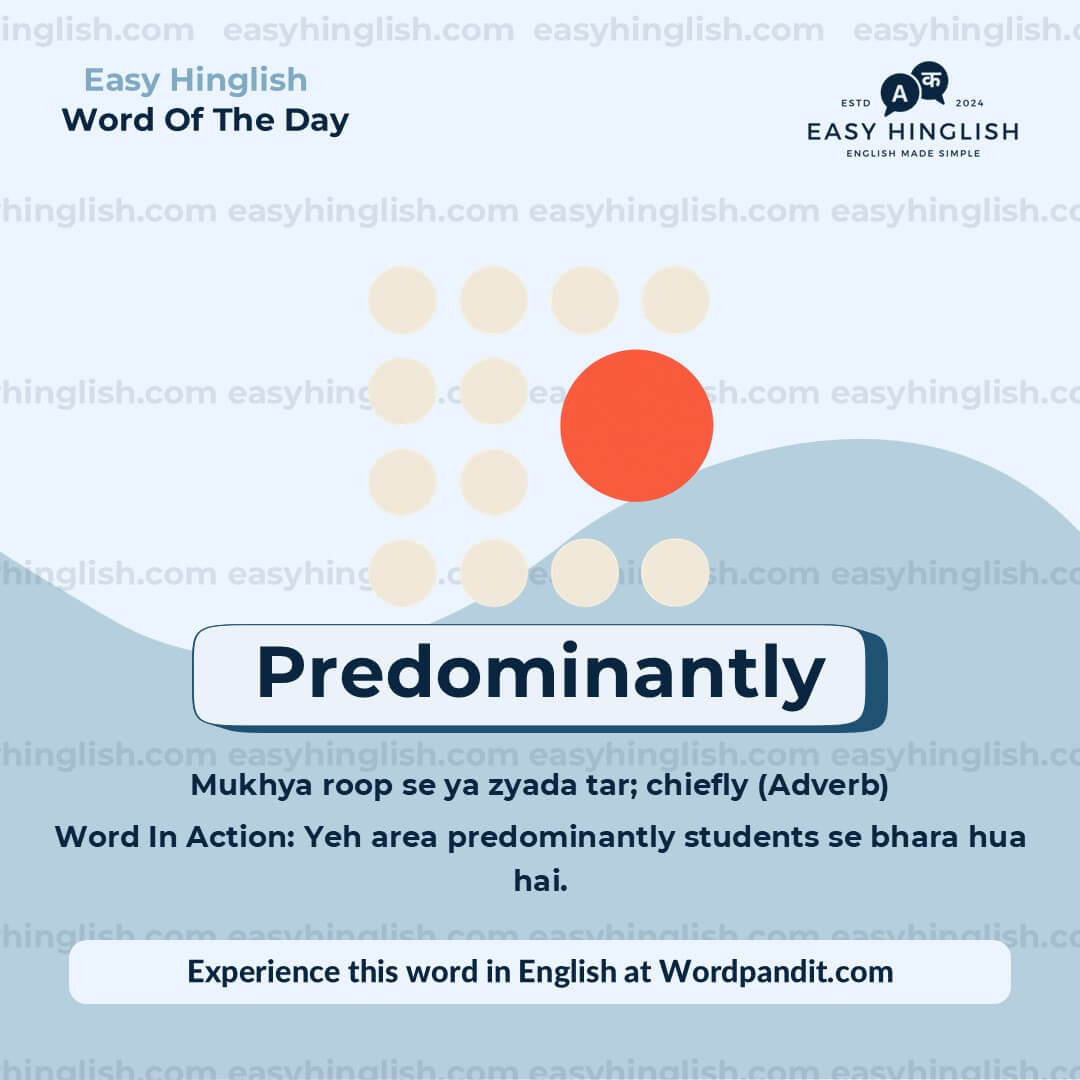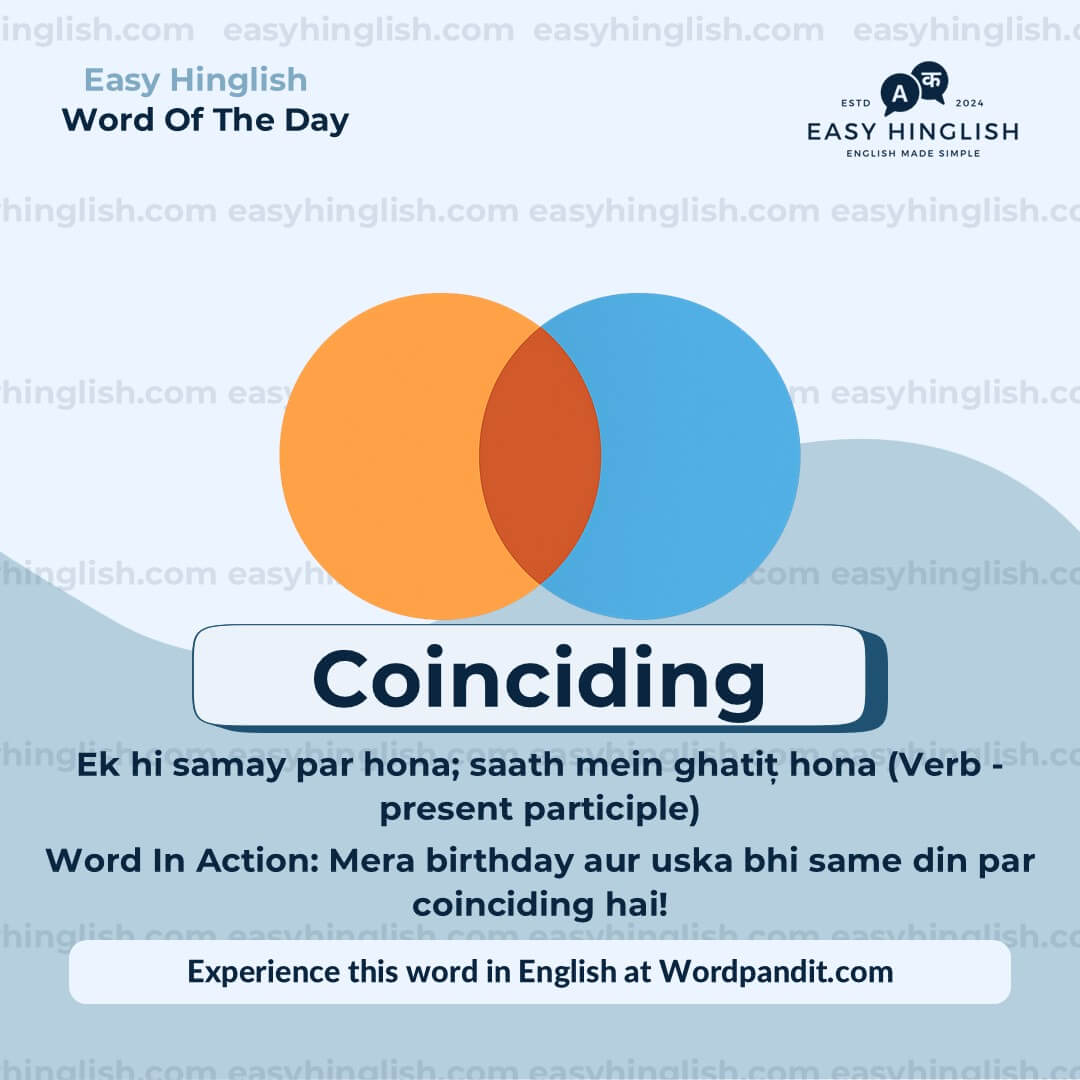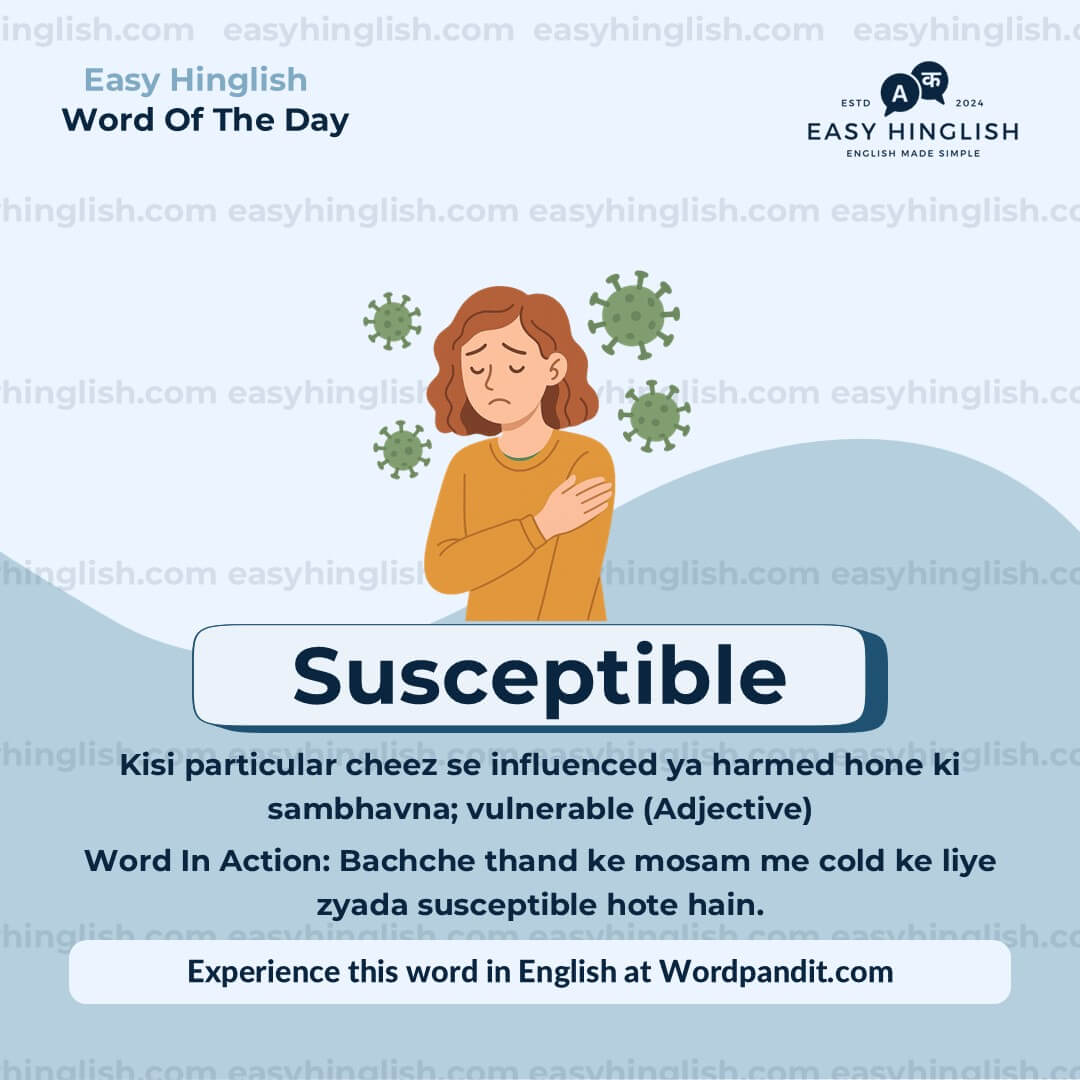Daily Vocabulary International Newspapers aur Publications se Seekho
Wordpandit ke Global Vocabulary Hub ke Saath Apni Vocabulary Expand Karo
Wordpandit par, hum aapko ek truly global vocabulary develop karne me madad karte hain, jo duniya ke sabse respected international publications se li gayi hoti hai. Yeh section aapko naye words se introduce karne ke liye design kiya gaya hai jo global conversations aur trends ko define karte hain.
Global Sources ka Power
Aapko globally sochne aur communicate karne me madad dene ke liye, hum vocabulary curate karte hain world ke top international sources se, jaise:
- The New York Times
- The Washington Post
- BBC
- The Guardian
- The Economist
- Scientific American
- Psychology Today
- Aur bhi bahut saare...
Globally Socho, Competitively Seekho
Hamare daily updates se aap international publications ke naye words seekhoge jo global news aur developments se jude hote hain. Isse aapki vocabulary current bhi rahegi aur globally relevant bhi.
Apni Global Soch Ko Expand Karo
Agar aap international exams ki tayari kar rahe ho, global business communication me excel karna chahte ho, ya sirf apni language skills improve karna chahte ho, toh Wordpandit aapko global level pe grow karne ke liye best resources provide karta hai.
Smart Learning, Global Reach
Hamari learning methodology me global examples, memory aids, aur interactive activities shamil hain, jo naye words ko effectively yaad karne aur real-world me use karne me madad karti hain.
Aaj Hi Apni Global Vocabulary Journey Shuru Karo!
Wordpandit Kyun Choose Karein?
Practical Learning: Aise words seekho jo real-world reading aur communication me aapko sach me kaam aayenge, taaki aapki comprehension aur bolne ki skills improve ho.
Diverse Content: Current affairs se lekar scientific breakthroughs tak, hamare different sources aapko multiple domains ki vocabulary seekhne ka moka dete hain.
Effortless Integration: Wordpandit ko apni daily routine ka part banao. Sirf kuch minute har din dene se aapki vocabulary time ke saath kaafi improve ho sakti hai.
Vocabulary Mastery Tak Ka Aapka Safar
- Regularly hamare Daily Vocabulary section ko visit karo
- Naye words explore karo aur unka context me use samjho
- In words ko apni writing aur bolne ki practice me use karne ki koshish karo
- Jaise-jaise aapke words badhte hain, apni progress ko track karo
Aaj Hi Apni Vocabulary Journey Shuru Karo!
Wordpandit ke saath vocabulary improve karna start karo. Roz thoda effort dalne se aap ek strong vocabulary develop kar sakte ho jo academic, professional, aur personal life me kaafi kaam aayegi.
Yaad rakho, ek naya shabd roz seekhna linguistic limitations ko door karne ka best tareeka hai! Wordpandit ko apni daily learning journey ka sathi banao aur vocabulary excellence ki taraf badho!
WORD-1: Predominantly
Sandarbh (Context):
"Outbreaks of influenza virus tend to occur seasonally each year, predominantly in winter..." - Scientific American
Vyakhya (Explanatory Paragraph):
Predominantly ka matlab hai 'zyada tar ya mostly; mukhya roop se.' Yeh word tab use hota hai jab koi cheez zyada tar ya sabse common ho, lekin doosre possibilities bhi exist kar sakti hain. Predominantly kaise use karte hain yeh samajhna aasan hai jab aapko kisi cheez ka primary characteristic ya most frequent occurrence describe karna ho. Academic writing, research papers, news articles aur competitive exam passages jaise CAT aur GRE mein predominantly ka upyog kab hota hai jab main ya most significant aspect ko indicate karna ho while acknowledging minor exceptions.
Arth (Meaning): mukhya roop se ya zyada tar; chiefly (Adverb)
Uccharan (Pronunciation): prih-DOM-ih-nunt-lee / प्रिडॉमिनन्ट्ली
Kathinai Star (Difficulty Level): ⭐⭐⭐ Intermediate
Utpatti (Etymology): Predominantly Latin word 'dominari' se aaya hai jiska matlab hai 'rule karna ya power rakhna,' 'predominate' ke through. Yeh word physical ya political dominance describe karne se evolve karke ab numerical ya proportional superiority indicate karta hai. '-ly' suffix ne adjective 'predominant' ko adverb mein transform kar diya, jisse yeh verbs ko modify kar sake aur describe kare ki koi cheez mainly ya chiefly kaise hoti hai.
Prashant Sir Ke Tathya (Prashant Sir's Notes):
Bahut students predominantly ko 'completely' ya 'entirely' se confuse karte hain—predominantly aur completely mein kya farak hai yeh samajhna important hai: predominantly hamesha exceptions ke liye room chhodta hai, jabki completely means 100%. CAT aur GRE ke students ke liye, predominantly aksar data interpretation passages aur research-based RC mein dikhta hai jahan majority trends identify karni hoti hain bina absolute statements ke. Students often poochhte hain: predominantly aur mainly mein difference kya hai? Dono synonyms hain, lekin predominantly ka sahi istemal formal writing mein zyada academic aur precise lagta hai. Indian newspapers mein aapko predominantly aksar demographic reports mein milega jaise "India's workforce is predominantly young" ya economic analyses mein, jo UPSC aur Bank PO exams ke liye zaroori vocabulary hai.
Samanarthi & Vipritarthi (Synonyms & Antonyms):
Samanarthi (Synonyms): mainly, mostly, chiefly, primarily, principally, largely, zyada tar, mukhya roop se, generally, overall
Vipritarthi (Antonyms): rarely, minimally, slightly, marginally, kam se kam, secondarily
Udaharan (Usage Examples):
- Indian IT industry predominantly Bengaluru, Hyderabad aur Pune jaise cities mein concentrated hai, though chhote hubs bhi emerge ho rahe hain.
- Priya ka investment portfolio predominantly equity mutual funds se composed hai, sirf thoda allocation debt instruments mein hai.
- Research data ne dikhaya ki CAT aspirants predominantly quantitative aptitude section ke saath struggle karte hain rather than verbal ability.
- Mumbai ki local trains predominantly morning rush hours mein crowded hoti hain, jo 9 AM local ko commuters ke liye particularly challenging bana deti hai.
Sanskritik Sandarbh (Cultural Reference):
"Indian cinema predominantly Hindi films se dominated tha jab tak regional cinema ne Baahubali aur RRR jaise pan-India releases ke through massive recognition gain nahi kari." - Indian film industry ki evolution par commentary
Sochiye (Think About It):
Society, business, ya science mein trends describe karte waqt hum 'predominantly' kyun use karte hain 'completely' ki jagah? Yeh word choice communication mein accuracy ke baare mein kya reveal karta hai?
Chhoti Kriya (Quick Activity):
Aaj ke newspaper ko dekho aur teen headlines ya sentences dhundho jo majorities ya trends describe karte hain. Unhe 'predominantly' use karke rewrite karo taaki woh zyada academically precise ban jayein.
Yaad Karne Ka Tarika (Memory Tip):
'Predominantly' ko aise yaad rakho: 'PRE-DOMINANT-ly'—imagine karo ek cricket team jahan ek player DOMINANT force hai (jaise Virat Kohli apne peak mein), lekin team PREdominantly uske upar depend karti hai, though doosre bhi contribute karte hain. Yeh word signal karta hai 'mostly but not entirely.'
Vastavik Jeevan Me Upyog (Real-World Application):
Predominantly commonly research papers, business reports, aur data analysis mein use hota hai majority trends describe karne ke liye bina absolute claims ke. Corporate presentations mein professionals iska use market share, customer demographics, ya resource allocation discuss karne ke liye karte hain. Competitive exam aspirants ke liye, predominantly ko samajhna inference questions answer karne mein madad karta hai jahan identify karna hota hai ki reading comprehension passages mein kya 'mostly true' hai versus kya 'always true' hai.
WORD-2: Coinciding
Sandarbh (Context):
"...that surged in Australia and New Zealand over the past two months, coinciding with the end of winter…" - Scientific American
Vyakhya (Explanatory Paragraph):
Coinciding ka matlab hai 'ek hi samay par hona ya saath mein occur hona.' Yeh word tab use hota hai jab do ya zyada events simultaneously ho jayein, chahe by chance ho ya planned. Coinciding kaise use karte hain yeh samajhne ke liye events ke beech temporal relationship dikhana zaroori hai bina necessarily causation imply kiye. Academic writing, research articles, news reports aur competitive exam passages jaise CAT, GRE aur UPSC mein coinciding ka upyog concurrent occurrences aur temporal patterns describe karne ke liye hota hai.
Arth (Meaning): ek hi samay par hona; saath mein ghatiț hona (Verb - present participle)
Uccharan (Pronunciation): koh-in-SY-ding / कोइन्साइडिंग
Kathinai Star (Difficulty Level): ⭐⭐ Basic se Intermediate
Utpatti (Etymology): Coinciding Latin ke 'co-' se aaya hai jiska matlab hai 'together' aur 'incidere' meaning 'fall upon ya happen,' Medieval Latin 'coincidere' ke through. Yeh word originally un cheezों ko describe karta tha jo same space ya position occupy karti thi, lekin evolve karke ab temporal overlap emphasize karta hai. Cheezों ka time mein 'falling together' ka concept perfectly capture karta hai ki coinciding modern usage mein simultaneous events ko kaise describe karta hai.
Prashant Sir Ke Tathya (Prashant Sir's Notes):
Bahut students coinciding ko 'causing' se confuse karte hain—coinciding aur causing mein kya farak hai yeh critical distinction hai: coinciding ka matlab sirf same time par hona hai, jabki causing imply karta hai ki ek event doosre ko lead karta hai. GRE aur CAT aspirants ke liye yeh distinction crucial hai reading comprehension mein jahan identify karna hota hai ki passage correlation suggest kar raha hai ya causation. Students aksar poochhte hain: coinciding aur corresponding mein difference kya hai? Dono alignment suggest karte hain, lekin coinciding ka sahi istemal specifically timing emphasize karta hai, jabki corresponding matching patterns ya relationships par focus karta hai. Indian newspapers mein jab festivals jaise Diwali coinciding with quarterly results announcements ya elections coinciding with monsoon season ka zikr hota hai, toh yeh word frequently temporal analysis mein appear hota hai.
Samanarthi & Vipritarthi (Synonyms & Antonyms):
Samanarthi (Synonyms): concurrent, simultaneous, synchronous, corresponding, coexisting, overlapping, ek saath hona, parallel, contemporaneous, concomitant
Vipritarthi (Antonyms): separate, distinct, diverging, alag alag, sequential, successive
Udaharan (Usage Examples):
- Naye smartphone ki launch festive season ke saath coinciding hone se Indian retail markets mein sales boost hui significantly.
- Rahul ka promotion announcement uski wedding celebration ke saath coinciding hua, jo uske poore family ke liye especially memorable month ban gaya.
- Stock market crash global pandemic ke saath coinciding hone se investors aur financial institutions ke liye unprecedented challenges create hui worldwide.
- Mere board exams IPL season ke saath coinciding the terrible timing thi, kyunki main cricket matches dekhne ka temptation resist karte hue study karne mein struggle kar raha tha.
Sanskritik Sandarbh (Cultural Reference):
"Shah Rukh Khan ki comeback film 'Pathaan' ka Republic Day weekend ke saath coinciding hona ek strategic masterstroke tha, jisse record-breaking opening collections mile." - Bollywood box office strategy ka analysis
Sochiye (Think About It):
Jab major life events coincide karte hain—jaise personal crises ke dauran job opportunities appear hoti hain—kya yeh pure chance hai, timing hai, ya simultaneous occurrence ek meaning create karta hai jo hum khud construct karte hain?
Chhoti Kriya (Quick Activity):
Apni life mein recently coincide hone wale events ke baare mein do sentences likho—ek positive coincidence aur ek challenging coincidence. Timing par focus karo, causation par nahi.
Yaad Karne Ka Tarika (Memory Tip):
'Coinciding' ko tod ke dekho: 'CO-IN-CIDING'—'CO' matlab 'together' aur 'INCIDING' matlab 'incidents happening.' Imagine karo do trains platform par exact same moment mein aa rahi hain—woh CO-incidents hain, time mein perfectly coinciding kar rahi hain.
Vastavik Jeevan Me Upyog (Real-World Application):
Coinciding business reports aur project management mein essential hai overlapping timelines, parallel developments, ya simultaneous market trends describe karne ke liye. Academic research aur data analysis mein yeh temporal correlations describe karne mein madad karta hai bina causation imply kiye. UPSC aspirants ke liye essays ya mains answers likhte waqt, coinciding use karna sophisticated understanding demonstrate karta hai historical events, policy implementations, ya social phenomena mein temporal relationships ki. Journalists iska use frequently karte hain jab same time par hone wale events report karte hain, jo isse current affairs analysis ke liye valuable vocabulary banata hai.
WORD-3: Susceptible
Sandarbh (Context):
"Nations that are about to enter winter will be more susceptible to outbreaks." - Scientific American
Vyakhya (Explanatory Paragraph):
Susceptible ka matlab hai 'kisi cheez se easily influenced ya harmed hona; vulnerable ya prone hona.' Yeh word tab use hota hai jab kisi person ya cheez ko describe karna ho jo external factors, diseases, emotions, ya influences se aasani se affect ho sakta hai. Susceptible kaise use karte hain yeh samajhne ke liye un situations ko identify karna padta hai jahan vulnerability ya openness to impact exist karta hai. Medical writing, scientific research, psychological contexts aur competitive exam passages jaise CAT, GRE aur UPSC mein susceptible ka upyog vulnerability patterns aur risk factors describe karne ke liye hota hai.
Arth (Meaning): kisi particular cheez se influenced ya harmed hone ki sambhavna; vulnerable (Adjective)
Uccharan (Pronunciation): suh-SEP-tih-buhl / ससेप्टिबल
Kathinai Star (Difficulty Level): ⭐⭐⭐ Intermediate
Utpatti (Etymology): Susceptible Latin word 'suscipere' se aaya hai jiska matlab hai 'take up ya receive karna,' jo 'sus-' (up from below) aur 'capere' (to take) se bana hai. Late Latin 'susceptibilis' ke through, yeh word evolve hua aur ab kisi cheez se affected hone ki capacity describe karta hai. Originally neutral tha aur receptiveness suggest karta tha, lekin gradually word ne apna modern sense acquire kar liya vulnerability ka, jo negative influences ya harm ke liye openness emphasize karta hai rather than just general receptiveness.
Prashant Sir Ke Tathya (Prashant Sir's Notes):
Bahut students susceptible ko 'vulnerable' se confuse karte hain—dono harm ke liye openness indicate karte hain, lekin susceptible aur vulnerable mein kya farak hai yeh samajhna zaroori hai: susceptible affected hone ki likelihood ya tendency emphasize karta hai, jabki vulnerable exposed hone ki state par focus karta hai. CAT aur GRE reading comprehension mein, susceptible ka sahi istemal aksar scientific passages mein risk factors discuss karte waqt hota hai, jo inference questions ke liye crucial hai. Students often poochhte hain: susceptible correctly prepositions ke saath kaise use karte hain? Yaad rakho: aap susceptible TO something hote ho (diseases, influence, criticism), na ki susceptible FOR ya OF. Indian English medical reporting mein aapko frequently milega "children are more susceptible to seasonal infections" ya "diabetic patients are susceptible to complications," jo isse UPSC health policy questions aur Bank PO exams ke general awareness sections ke liye essential vocabulary banata hai.
Samanarthi & Vipritarthi (Synonyms & Antonyms):
Samanarthi (Synonyms): vulnerable, prone, liable, inclined, predisposed, subject to, open to, receptive, exposed, risk mein, sensitive
Vipritarthi (Antonyms): resistant, immune, invulnerable, protected, insusceptible, unaffected, surakshit, impervious
Udaharan (Usage Examples):
- Chhote bachche aur elderly citizens particularly susceptible hote hain respiratory infections ke liye Delhi ke severe winter pollution episodes ke dauran.
- Investors jo emotional decisions lete hain woh zyada susceptible hote hain market manipulation aur panic selling ke liye volatile trading sessions mein.
- Students jo competitive exams ke liye proper guidance ke bina prepare karte hain woh susceptible hote hain misinformation aur coaching scams ke liye unverified online sources se.
- Priya ko realize hua ki woh social media influence ke liye susceptible thi aur usne better mental health maintain karne ke liye apna screen time limit karne ka decide kiya.
Sanskritik Sandarbh (Cultural Reference):
"Film '3 Idiots' mein Rancho warn karta hai ki students jo blindly conventional paths follow karte hain woh susceptible hote hain apna passion aur creativity khone ke liye grades aur placements ki pursuit mein." - Indian society mein educational pressure par reflection
Sochiye (Think About It):
Kya hum sab equally susceptible hain advertising aur social media influence ke liye, ya self-awareness immunity create karti hai? Kuch logon ko doosron se zyada susceptible kya banata hai?
Chhoti Kriya (Quick Activity):
Teen situations identify karo jahan aap sabse zyada susceptible feel karte ho external influence ke liye—peer pressure, advertising, emotional manipulation, ya health risks. Har ek ke liye ek sentence likho explain karte hue kyun.
Yaad Karne Ka Tarika (Memory Tip):
'Susceptible' ko aise socho: 'SUS-ACCEPT-able'—imagine karo koi jo SUSpiciously easily sab kuch ACCEPT kar leta hai, jaise strangers se candy accept karna. Agar aap bahut accepting aur open ho, toh aap susceptible ho harm ya influence ke liye. Beech mein 'ACCEPT' ki awaaz yaad dilati hai ki susceptible log negative influences ko bhi too readily accept kar lete hain.
Vastavik Jeevan Me Upyog (Real-World Application):
Susceptible extensively medical literature, public health advisories, aur epidemiological reports mein use hota hai at-risk populations identify karne ke liye. Cybersecurity aur IT communications mein, professionals iska use systems describe karne ke liye karte hain jo attacks ya breaches ke liye vulnerable hain. UPSC aspirants ke liye health policy, social issues, ya disaster management par mains answers likhte waqt, susceptible use karna analytical thinking demonstrate karta hai vulnerability patterns ke baare mein. Business analysts is word ka use tab karte hain jab market segments discuss karte hain jo economic downturns ke liye susceptible hain ya consumer groups jo marketing strategies ke liye susceptible hain, jo isse MBA entrance exams aur corporate communications ke liye valuable banata hai.
WORD-4: Strain
Sandarbh (Context):
"...a strain of influenza A, called H3N2, that surged in Australia and New Zealand…" - Scientific American
Vyakhya (Explanatory Paragraph):
Strain ka matlab hai 'kisi organism ka particular breed, stock, ya variety, khaaskar microorganism ya virus jo genetically distinct characteristics rakhta hai.' Yeh word tab use hota hai jab species ke andar variations describe karne ho, particularly medical, biological, aur agricultural contexts mein. Strain kaise use karte hain yeh important ho jata hai jab diseases, bacteria, ya plants ke different versions discuss karne ho jo common ancestry share karte hain lekin unique features rakhte hain. Scientific research, medical reports, epidemics ke baare mein news articles aur competitive exam passages jaise UPSC, CAT aur GRE mein strain ka upyog biological variants aur disease types describe karne ke liye hota hai.
Arth (Meaning): microorganism, virus, ya plant ka genetic variant ya subtype (Noun); iska matlab pressure, tension ya force exert karna bhi hota hai (Multiple meanings)
Uccharan (Pronunciation): strayn / स्ट्रेन
Kathinai Star (Difficulty Level): ⭐⭐ Basic se Intermediate
Utpatti (Etymology): Strain Old English 'streon' se aaya hai jiska matlab hai 'gain, acquisition, ya offspring,' jo Latin 'struere' se related hai meaning 'to build ya pile up.' Biological contexts mein, yeh word evolve hua aur ab lineage ya stock of organisms matlab hai jo common characteristics share karte hain. 'Offspring' aur modern usage ke beech connection clear hai—ek strain descent ki line represent karta hai particular genetic traits ke saath. Interestingly, same word ka matlab 'tension ya pressure' bhi hai, jo Latin 'stringere' (to draw tight) se derived hai, jo dikhata hai ki English ne do etymologically distinct words ko ek spelling mein merge kar diya hai.
Prashant Sir Ke Tathya (Prashant Sir's Notes):
Bahut students strain ko 'virus' ya 'disease' se confuse karte hain—strain aur virus mein kya farak hai yeh critical distinction hai: virus pathogen ka type hai, jabki strain us virus type ke andar ek specific variant hai. UPSC aspirants ke liye, strain ka sahi istemal science and technology questions ke liye essential hai, especially pandemic-related current affairs ke dauran. Students aksar poochhte hain: strain aur variant mein difference kya hai? Biology mein dono terms nearly interchangeable hain, lekin strain zyada commonly microbiology aur medical contexts mein use hota hai, jabki variant recent COVID-19 discussions mein popular ho gaya hai. Indian newspapers mein health crises cover karte waqt aapko milega "new strain of dengue detected in Kerala" ya "drug-resistant strain of tuberculosis," jo isse SSC, Bank PO, aur civil services exams ke general awareness sections ke liye crucial vocabulary banata hai. Yaad rakho ki strain ke multiple meanings hain—biological variant, physical tension, ya pressure—toh context determine karta hai ki konsa meaning apply hoga.
Samanarthi & Vipritarthi (Synonyms & Antonyms):
Samanarthi (Synonyms): variant, type, variety, stock, breed, lineage, subtype, prakar (biological context mein); pressure, tension, stress, dabav, burden (physical/emotional context mein)
Vipritarthi (Antonyms): ease, relaxation, relief, aaram (jab tension refer kar rahe ho); uniformity, sameness, ekaroopata (jab variants refer kar rahe ho)
Udaharan (Usage Examples):
- Mumbai mein health authorities ne dengue virus ka ek naya strain identify kiya jo previous outbreaks mein use hone wale conventional treatment protocols ke liye resistance dikhata tha.
- IARI ke agricultural scientists ne wheat ka ek high-yield strain develop kiya jo specifically Rajasthan aur Madhya Pradesh ke drought-prone regions ke liye adapted hai.
- Research paper ne analyze kiya ki kaise same bacterial species ke different strains ne Indian hospitals mein varying levels of antibiotic resistance exhibit kiya.
- Teen consecutive months tak night shifts karne se Amit ki health par severe strain pada, jisse woh apne career priorities reconsider karne par majboor ho gaya.
Sanskritik Sandarbh (Cultural Reference):
"COVID-19 pandemic ke dauran, news channels constantly Delta aur Omicron strains discuss karte the, jisse terms jaise 'mutant strain' aur 'variant of concern' everyday Indian household conversations ka hissa ban gaye." - Indian media mein pandemic vocabulary par observation
Sochiye (Think About It):
Diseases ke naye strains hamare interconnected world mein zyada frequently kyun emerge hote hain, aur global travel novel strains ko continents ke across spread karne mein kaise accelerate karta hai?
Chhoti Kriya (Quick Activity):
Aaj ki health news search karo aur teen different contexts identify karo jahan 'strain' word use hua hai—biological, physical, ya emotional. Har context ke liye ek sentence likho jo different meanings dikhaye.
Yaad Karne Ka Tarika (Memory Tip):
'Strain' ko aise socho: 'S-TRAIN'—imagine karo different types of trains (local, express, Rajdhani) same railway track par. Jaise Indian Railways ke paas trains ke different strains (types) hain jo different purposes serve karte hain, waise hi viruses aur bacteria ke different strains hote hain unique characteristics ke saath. Har strain same family ka part hai lekin distinct features rakhta hai, bilkul jaise different train types same tracks share karte hain lekin different services offer karte hain.
Vastavik Jeevan Me Upyog (Real-World Application):
Strain essential vocabulary hai medical research papers, pharmaceutical documentation, aur public health announcements mein disease variants describe karne ke liye. Microbiologists aur healthcare professionals iska use antimicrobial resistance, vaccine development, aur epidemic tracking discuss karte waqt karte hain. Competitive exam aspirants ke liye, especially UPSC candidates jo science and technology ya health policy answers likh rahe hain, strain ko samajhna biotechnology, genetic engineering, aur epidemiology par passages analyze karne mein madad karta hai. Yeh word agriculture aur plant breeding contexts mein bhi frequently appear hota hai, jo isse green revolution, crop development, aur food security topics par prelims questions ke liye valuable banata hai.
WORD-5: Virologist
Sandarbh (Context):
"...says Vinod Balasubramaniam, a molecular virologist at Monash University Malaysia…" - Scientific American
Vyakhya (Explanatory Paragraph):
Virologist ka matlab hai 'ek scientist jo viruses aur viral diseases ki study mein specialize karta hai.' Yeh word tab use hota hai jab un professionals ko refer karna ho jo research karte hain ki viruses kaise function karte hain, spread hote hain, aur humans, animals aur plants mein infections cause karte hain. Virologist kaise use karte hain yeh samajhne ke liye yeh jaanna zaroori hai ki yeh experts vaccine development, disease outbreaks, aur viral behavior ko molecular levels par samajhne par kaam karte hain. Medical journalism, scientific publications, public health reports aur competitive exam passages jaise UPSC, CAT aur GRE mein virologist ka upyog infectious diseases, pandemic responses aur medical research discuss karte waqt hota hai.
Arth (Meaning): ek scientist jo viruses aur unke dwara caused diseases ka study karta hai (Noun)
Uccharan (Pronunciation): vy-ROL-uh-jist / वायरॉलजिस्ट
Kathinai Star (Difficulty Level): ⭐⭐⭐ Intermediate
Utpatti (Etymology): Virologist 'virus' (Latin se meaning 'poison ya slimy liquid') aur Greek suffix '-logist' (from 'logos' meaning 'study' ya 'knowledge') se bana hai. Yeh term early 20th century mein emerge hua jab virology ek distinct scientific discipline ban gayi, separate from bacteriology aur microbiology. Jab scientists ne discover kiya ki certain infectious agents bacteria se chhote hain aur living cells ko reproduce karne ke liye require karte hain, tab virology ka field born hua, aur is area ke specialists virologists ke naam se jaane gaye. Suffix '-logist' indicate karta hai koi jo particular subject ko systematically study karta hai.
Prashant Sir Ke Tathya (Prashant Sir's Notes):
Bahut students virologist ko 'microbiologist' se confuse karte hain—virologist aur microbiologist mein kya farak hai yeh key distinction hai: virologists specifically viruses study karte hain, jabki microbiologists sabhi microscopic organisms study karte hain including bacteria, fungi, aur viruses. UPSC science and technology questions ke liye, virologist ka sahi istemal aapko disease outbreaks aur medical research ke baare mein passages mein expert credentials recognize karne mein madad karta hai. Students aksar poochhte hain: virologist aur immunologist mein difference kya hai? Jabki virologists viruses khud ko study karte hain, immunologists immune system ke infections ke response par focus karte hain. COVID-19 pandemic ke dauran, ICMR, NIV Pune, aur AIIMS se Indian virologists household names ban gaye, jo isse current affairs ke liye essential vocabulary banata hai. Competitive exam reading comprehension mein, jab aap kisi ko virologist ke roop mein identified dekho, woh viral diseases, vaccine efficacy, aur epidemic predictions par authoritative source hain—yeh inference aur tone questions correctly answer karne mein madad karta hai.
Samanarthi & Vipritarthi (Synonyms & Antonyms):
Samanarthi (Synonyms): virus researcher, infectious disease specialist, epidemiologist (broader), microbiologist (broader), medical researcher, viral disease expert, virus visheshan
Vipritarthi (Antonyms): (Koi direct antonyms nahi, lekin contrasting professions) layperson, non-specialist, generalist, aam aadmi
Udaharan (Usage Examples):
- Dr. Gagandeep Kang, ek leading Indian virologist, ne rotavirus vaccine research mein extensively contribute kiya hai jisne globally millions children ki lives save ki hain.
- Press conference mein ICMR ke renowned virologists featured the jo explain kar rahe the ki naya influenza strain India mein circulating previous seasonal variants se kaise different hai.
- Virologist banne ki aspiration rakhte hue, Sneha ne NCBS Bangalore se microbiology mein PhD pursue ki with specialization in viral pathogenesis.
- Kerala mein Nipah virus outbreak ke dauran news channels ne several virologists ko interview kiya, containment strategies aur transmission patterns par expert opinions seek karte hue.
Sanskritik Sandarbh (Cultural Reference):
"2011 ki film 'Contagion' ne virologists ko mainstream consciousness mein laya, dikhate hue ki kaise yeh scientists deadly pathogens ko samajhne ke liye time ke against race karte hain—ek scenario jo COVID-19 ke dauran reality ban gaya jab worldwide virologists media personalities ban gaye pandemic science explain karte hue." - Popular culture mein scientific expertise par observation
Sochiye (Think About It):
Pandemic ke dauran virologists achanak trusted public figures kyun ban gaye, aur yeh crises ke dauran scientific expertise ke saath hamare relationship ke baare mein kya reveal karta hai?
Chhoti Kriya (Quick Activity):
Recent health concerns discuss karte hue Indian virologists featuring news articles search karo. Notice karo ki unke credentials kaise present kiye gaye hain aur kyun unki expertise unke statements ko weight deti hai. 'Virologist' use karte hue different contexts mein do sentences likho.
Yaad Karne Ka Tarika (Memory Tip):
'Virologist' ko tod ke dekho: 'VIRUS + OLOGIST'—'OLOGIST' ko socho as 'one who studies' (jaise psychologist psyche study karta hai, biologist biology study karta hai). Ek virologist simply hai VIRUS + OLOGIST = koi jo viruses study karta hai. Imagine karo ek detective magnifying glass ke saath tiny viruses ko microscope ke neeche examine kar raha hai—that's your virologist, the virus detective!
Vastavik Jeevan Me Upyog (Real-World Application):
Virologist frequently medical journalism, scientific publications, aur public health communications mein appear hota hai, especially disease outbreaks aur vaccination campaigns ke dauran. UPSC aspirants ke liye, is term ko samajhna science and technology, current affairs, aur health policy questions mein madad karta hai. Jab reading comprehension passages virologists ko quote karte hain, woh authoritative scientific voices represent karte hain jinke statements disease transmission, vaccine development, aur epidemic management par credibility carry karte hain. Mains answer writing mein, NIV Pune, ICMR, ya AIIMS jaise institutions ke virologists ko reference karna healthcare infrastructure aur pandemic preparedness ke baare mein arguments ko expert validation add karta hai. Yeh term SSC aur Bank PO general awareness sections ke liye bhi valuable hai jo health aur science topics cover karte hain.













